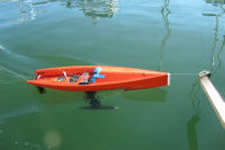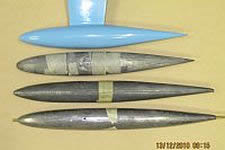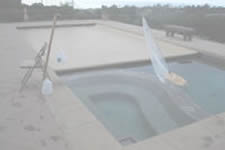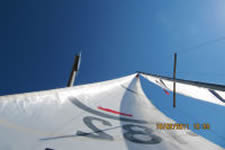Thoughts on Chines
Chines came on the IOM scene several years ago and have dominated the prize lists ever since. The general wisdom is that they gain most on the windward leg. The interesting question is why? This article gives some thoughts on chines. These ideas are really just speculations with at best a soupcon of logic or data behind them. With this caveat, the following are some possible reasons why chines could be thought to work so well:
• As David Hollom suggested in the Seattle newsletter, the presence of chines aft allows for a narrower band of separation at the stern when heeled and this is likely to reduce drag. Of course this only works when the boat is heeling enough.
• Depending on the design, it seems a reasonable speculation that the wetted surface and the drag when heeled well over may be significantly less with a correctly placed chine and tumblehome than for a slab sided or flared cross section. Hopefully I will get round to looking at this in a more quantitative manner sometime!
• In dinghies I designed two round bilge boats. These were very good in waves and the first one got first and second in the championships that year. The second round bilge one had hollow waterlines forward and a very low wetted surface, and was faster than the first. It proved very quick upwind, especially in waves, and very quick though the transition from displacement to planning but it fell short of the chine boats in flat out planning, though it was pre-eminent for river sailing where flat out planning was rare. In hindsight it would have been better to have a chine over the last half to one third of the hull to allow the water to break away more cleanly from the aft sections. This would have provided a bit more dynamic lift and also would have reduced the wetted area by stopping water from running up the flared sides aft. Frank and Julian Bethwaite did some experiments on how sharp the chines should be, and came up with a 2% gain by going from pencil round to a sharp chine aft.
• Several designers have said that they believe the topside on the lee side projects a flat surface and that helps reduce leeway. Personally, this seems unlikely to be a significant effect but the truth is that I have no data.
• There is another rather exotic possibility. I have noticed that when pressed to windward near hull speed, some IOM designs develop an exaggerated trough in the bow to stern wave and I would speculate that this may be due to the low pressure area on the windward side of the keel pulling the trough downward. If the chine allows the top of the keel to be a bit lower down from the surface, this might (?) be avoided.
It is interesting to speculate what the next jump will be. There are designs out there like the D2 IOM from New Zealand and some others in development here in Australia that address wave impact. The ones I have seen are going down the route of the bow shapes on the current crop of America’s Cup multihulls, the idea being that the bow can go into the wave and emerge without much effort. There will be nosediving and other issues with this, but I expect you clever designers will come up with something workable.
Colin Thorne July 2013




 Hulls
Hulls